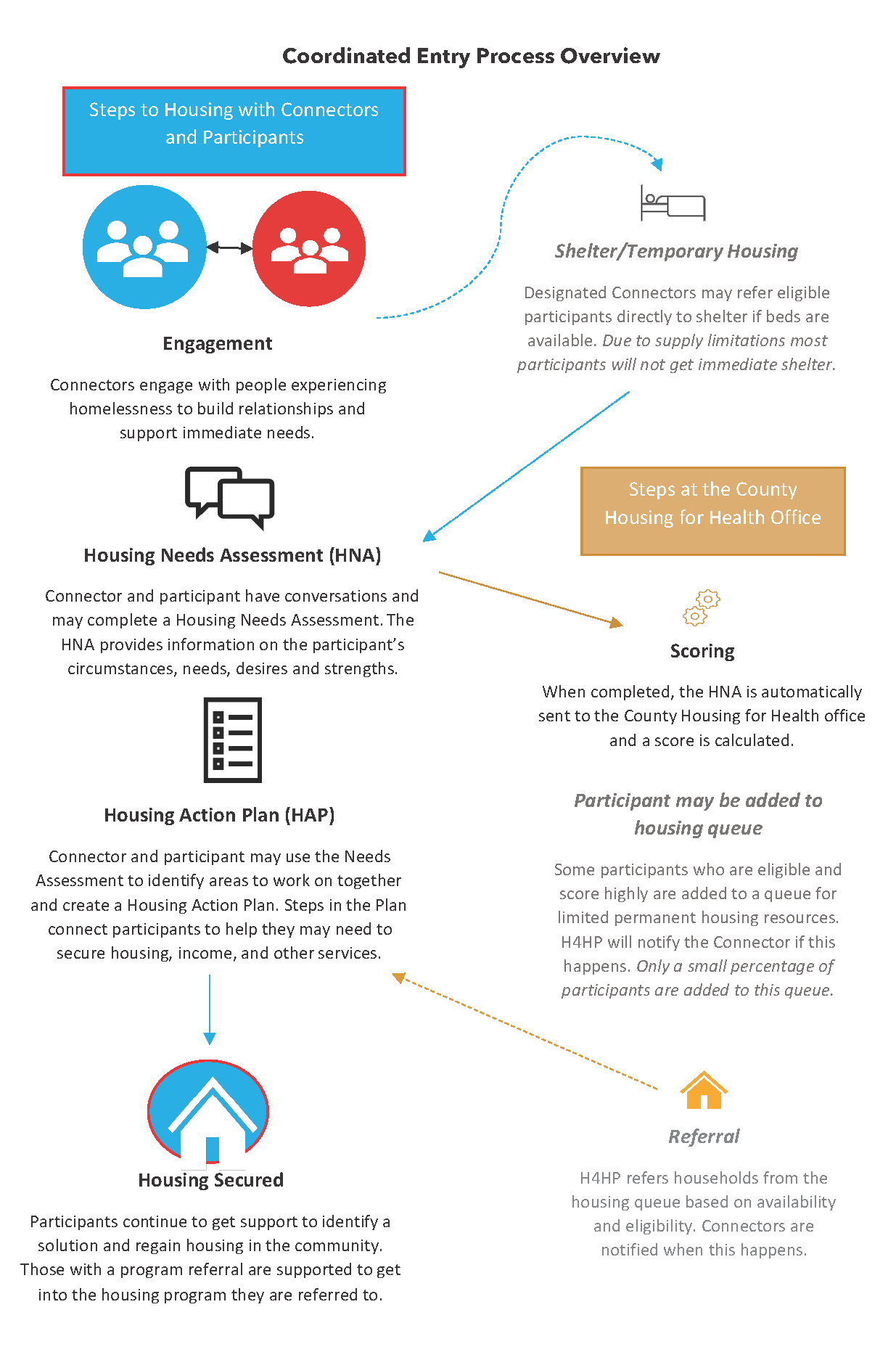H4HP Coordinated Entry – A New Connection Approach
Connection Services Request Form
H4HP Coordinated Entry Policies April 2023

Update for March 30, 2023
Coordinated Entry is a systemic approach to connecting people experiencing homelessness with available assistance in the community. It is an important way to ensure fair and equitable access to limited housing resources and is a Federal and State requirement.
After a three-month pilot period, in April 2023, Santa Cruz County Housing for Health Partnership (H4HP) has launched a redesigned Coordinated Entry System. The new system uses designated Connectors applying housing problem solving techniques and a new assessment and planning tools to assist as many people experiencing homelessness as possible. The approach recognizes that there isn’t an immediate housing resource available for each person, so focuses on providing individual assistance to help people gain access to an array of potential supports rather than putting everyone on a list that, for most, does not result in regaining housing.
The goals of the new Coordinated Entry System are to (1) Facilitate connections to mainstream and community services for as many persons experiencing homelessness as local resources allow; (2) Streamline the process for matching to limited housing resources within the Housing for Health Partnership network (CoC); and (3) Prioritize resources for households with the most significant barriers to getting and keeping housing and for those with the greatest personal health and safety risks.
H4HP Connectors may work as part of an outreach team, drop-in center, multi-service center, or other program serving people experiencing or at risk of homelessness. They engage with persons experiencing homelessness, build rapport, enroll participants in HMIS programs and collect participant data. Connectors offer problem solving assistance with all participants and may conduct a Housing Needs Assessment (HNA). The HNA provides Connectors and participants with information needed to create and act together on an individualized Housing Action Plan and provides information to determine which participants are eligible and prioritized for H4H-supported housing and services. Only the highest priority households are added to the queue for the system’s limited housing resources.
Status of Coordinated Entry Transition
The rollout of the new Coordinated Entry system took place in a phased process. The prior assessment tool (the VI-SPDAT) was retired on December 31, 2022. Since January 2023, H4H has been making referrals from those that were prioritized under the former Smart Path CES model and that had recent service history records in HMIS. The Housing Needs Assessment also rolled out in January 2023 and Connectors have been reaching out to engage with anyone still on the previous list. When this process is completed and the list exhausted (anticipated to be in April), matching from the new Housing Queue will begin.
The current capacity for conducting Housing Needs Assessments is limited by the number of available Connectors and the training and technology needs associated with the role. Connectors may be dedicated full-time to CES or may have other roles within an agency so long as they are able to do Connector functions. They work intensively with participants and have limited caseloads; some Connectors take new participants only from within their agencies or from specific subpopulations, such as families or youth, while others may work with anyone experiencing homelessness. H4H will be expanding the number of Connectors as quickly as possible. Agencies interested in learning more about the Connector role and potentially becoming a Connection Point should contact HousingforHealth@santacruzcounty.us.
To help the community understand the new approach, H4H will provide a series of presentations, including a recorded webinar in the Spring as well as presentations to specific groups and community organizations. More information and presentation dates will be available shortly.
The Coordinated Entry Redesign is part of a larger system-wide effort the Housing for Health Partnership is launching in 2023. H4H Division staff will be working with partner organizations and providers to more fully develop a data-driven system by implementing updated Homeless Management Information System (HMIS) policies and procedures and coordination around data use and interpretation for addressing system issues.
Additional updates on the CES transition and redesign will be available on this webpage as they roll out. Questions can be directed to HousingforHealth@santacruzcounty.us.